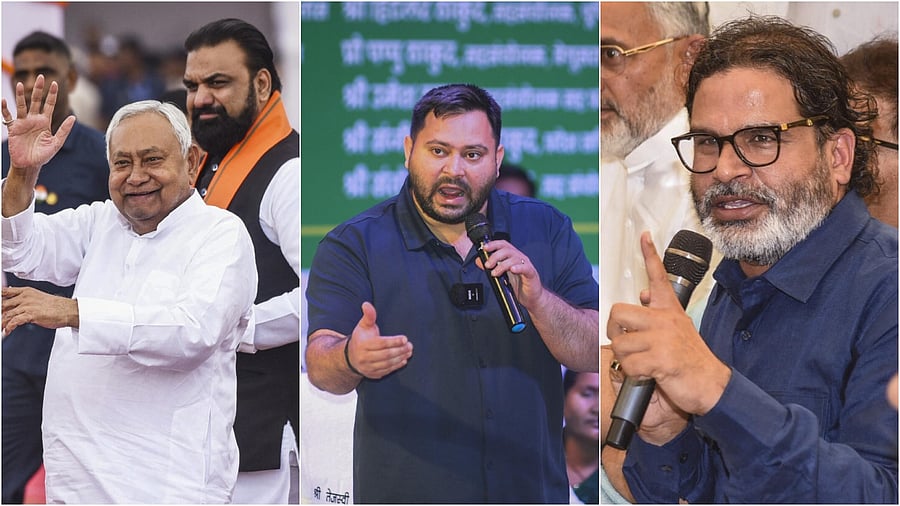
From left: Nitish Kumar, Tejashwi Yadav and Prashant Kishore.
Credit: PTI Photos
With Election Commission's announcement for Bihar elections, the state has officially entered political season which is expected to throw some interesting battles and strange alliances post-results. Over the last decade and half, the state has seen three Assembly elections - 2010, 2015 and 2020. Dramatic cycle of alliances, anti-incumbency, and shifting voter aspirations along with the complex equations between Nitish Kumar's JD(U), Lalu Prasad Yadav’s RJD, and the BJP have been a constant in all these years. There have also been small yet significant players like Left bloc, LJP, HAM and VIP.
Let's take a look on all three
2010: Nitish–BJP Alliance at its peak
The 2010 election can easily be termed as a watershed moment for governance-based politics in Bihar which also resulted in the electoral success peak for JD(U)-BJP alliance in the state. NDA, winning 206 seats, secured a landslide victory with JD(U)'s tally going upto 115 and BJP to 91. Nitish Kumar’s image as a 'vikas-purush' resonated deeply, while the Lalu Prasad-led alliance of RJD and LJP suffered its worst defeat.
RJD could win only 22 seats and Ram Vilas Paswan's LJP managed to secure only 3 seats in the assembly of 243 members. Congress decided to go alone in polls which reduced the party further in the state. Voters through the mandate gave a clear message regarding their preference for stability and developmental politics over caste arithmetic.
| Party | Vote Share (%) | Seats won |
|---|---|---|
| Janata Dal (United) | 22.58 | 115 |
| Bharatiya Janata Party | 16.49 | 91 |
| Rashtriya Janata Dal | 18.84 | 22 |
| Lok Janshakti Party | 6.74 | 3 |
| Congress | 8.37 | 4 |
| Communist Party of India | 1.69 | 1 |
| Jharkhand Mukti Morcha | 0.61 | 1 |
| Independents | 13.22 | 6 |
2015: Mandate for Mahagathbandhan
Not every election in a democracy produces the same result and 2015 proved this. In 2015 Bihar Assembly Elections, fortunes of all parties turned dramatically. The state witnessed new alliances and equations. After parting ways in 90s, the two tall socialist leaders of the state - Nitish Kumar and Lalu Prasad joined hands in a bid to eliminate the threat of BJP. RJD, JD(U), and Congress formed the Mahagathbandhan. This social coalition, which had Nitish’s governance credibility and Lalu’s caste base, proved formidable.
The Mahagathbandhan won 178 seats against the BJP-led NDA which could win only 58. The results reaffirmed the enduring pull of social justice politics when combined with credible leadership. However, the unity was short-lived and Nitish Kumar’s return to the NDA in 2017 exposed the fragility of alliances which was primarily built on electoral convenience.
| Party | Vote Share (%) | Seats won |
|---|---|---|
| Rashtriya Janata Dal | 18.4 | 80 |
| Janata Dal (United) | 16.8 | 71 |
| Indian National Congress | 6.7 | 27 |
| Bharatiya Janata Party | 24.4 | 53 |
| Lok Janshakti Party | 4.8 | 2 |
| Rashtriya Lok Samata Party | 2.6 | 2 |
| Hindustani Awam Morcha | 2.3 | 1 |
| CPI(ML) Liberation | 1.54 | 3 |
| Independents | 9.4 | 4 |
2020: NDA retains power, RJD emerges stronger
2020 Assembly polls in Bihar, were again an election of completely different outcomes. Although NDA managed to form the govt again in the state, anti-incumbency was clearly visible on ground. That was also the year of reverse migration due to pandemic-induced distress. The pain of going to some other state to earn livelihood became a talking point during that election among voters.
Still, NDA secured 125 seats, due to BJP’s stronger showing (74 seats) compared to JD(U)’s decline to 43. Lalu's RJD again emerged as the single largest party with 75 seats due to Tejashwi Yadav’s energetic campaign. This signaled generational change and renewed opposition momentum. The fine reading of results reflected a split verdict, a tired mandate for continuity and the promise of youthful leadership.
| Party | Vote Share (%) | Seats won |
|---|---|---|
| Bharatiya Janata Party | 19.46 | 74 |
| Janata Dal (United) | 15.39 | 43 |
| Vikassheel Insaan Party | 1.52 | 4 |
| Hindustani Awam Morcha | 0.89 | 4 |
| Rashtriya Janata Dal | 23.11 | 75 |
| Indian National Congress | 9.48 | 19 |
| Communist Party of India (ML) L | 3.16 | 12 |
| Communist Party of India | 0.83 | 2 |
| Communist Party of India (M) | 0.65 | 2 |
| AIMIM | 1.24 | 5 |
| Bahujan Samaj Party | 1.49 | 1 |
| Lok Janshakti Party | 5.66 | 1 |
| Independents | 8.64 | 1 |
2025: The emerging triangular contest
As Bihar again is approaching assembly election, the state faces a potentially transformative contest. NDA remains intact but internal frictions and anti-incumbency can't be ruled out. The I.N.D.I.A. bloc, led by RJD, eyes consolidation of anti-NDA sentiment. Not to forget the voters' desire for a change of face since it's almost 20 years of Nitish Chief Minister-ship in the state. Meanwhile, Prashant Kishor’s Jan Suraaj movement could emerge as a credible third force and can dent the prospects of the established political forces on at least few seats. Kishor is trying hard to woo educated youth and reform-minded voters disillusioned with both camps.
2010 was about governance, 2015 about coalition arithmetic and 2020 about generational transition. But 2025 may test whether Bihar’s voters are ready to break from legacy politics altogether.